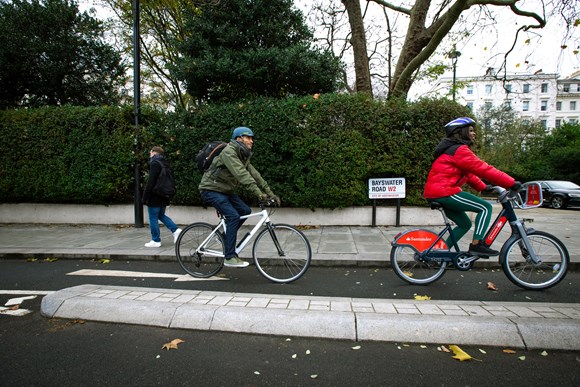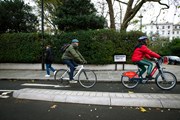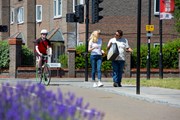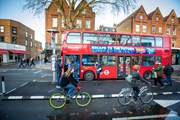
Wednesday 30 Nov 2022
TfL Press Release - New TfL data shows continued boom in walking and cycling, with almost twice as many now living near a high-quality cycle route

PN-123
- TfL has published data from its Travel in London report, which shows trends in travel during 2020, 2021 and into 2022
- The number of people cycling and walking continues to exceed pre-pandemic levels, while the number of people living within 400 metres of a high-quality cycle route has almost doubled since 2019
- Enabling more people to walk, cycle and use public transport is a vital part of building a healthier and more sustainable capital for everyone
Transport for London (TfL) has published data from its annual Travel in London report, showing there has been a continued boom in walking and cycling in London, with levels of cycling remaining 40 per cent higher than levels seen before the pandemic.
Enabling more people to walk and cycle is vital to a sustainable transport network in the capital and TfL has worked closely with London’s boroughs to invest in high-quality infrastructure that allows more people to walk and cycle more often.
The report shows that levels of cycling continue to exceed pre-pandemic levels, with cycling in autumn 2022 40 per cent higher than in 2019. Cycling on weekdays this autumn has also typically been around 20-25 per cent higher than pre-pandemic levels, despite less commuting, and around 90 per cent higher at weekends. Since the start of the pandemic and despite significant financial constraints, TfL has worked closely with boroughs across the capital to invest in and expand London’s network of Cycleways. The proportion of people living within 400 metres of a high-quality cycle route is now almost double what it was in 2019, with 22 per cent of Londoners now living near one, compared to 12 per cent in 2019.
Walking continues to be central to how many people travel in London, with levels still noticeably higher than before the pandemic. Around 35 per cent of journeys in London were made on foot before the pandemic. The latest quarter of available data, for April-September 2022, shows that the proportion of journeys made on foot is now 41 per cent, significantly above the pre-pandemic level. The data also shows the number of walking journeys that were made per person per day between April and September 2022 was 11 per cent higher than the 2019/20 pre-pandemic average.
Santander Cycles, which saw record levels of hires during the pandemic, continues to see record hire numbers, with hires at 11 per cent higher than the pre-pandemic level as of late September 2022. The scheme has broken a number of records this year, with 10.9 million hires so far in 2022. This is 762,500 higher than the same point last year, with every month from August 2021 to August 2022 recording the highest number of hires for the corresponding month. The recent introduction of e-bikes has added to the scheme’s popularity, with 86,000 hires now made.
The report also highlights the substantial improvements in air quality over recent years, reflecting the extension of the Ultra Low Emission Zone to inner London, with estimated reductions of 20 per cent in NO2 concentrations.
However, outer London now accounts for an increasing proportion of NOx and PM2.5 emissions from road transport and the Mayor's bold decision to expand the ULEZ London-wide will mean five million more Londoners will breathe cleaner air. The expansion of ULEZ to outer London will be supported by a range of measures to enable the switch to greener forms of transport, including a new and improved bus network and a new £110m scrappage scheme.
The report also outlines how passenger numbers on London’s public transport network continue to recover after the pandemic. As of October, demand for Tube services across the week was around 82 per cent of pre-pandemic levels, with weekend ridership levels on Tube and bus increasingly edging towards those seen pre-pandemic. Across the week, bus passenger numbers at 84 per cent of pre-pandemic levels, with the DLR and Trams are seeing around 80 per cent of their pre-pandemic levels of use and London Overground just below this. The report also shows how Londoners are taking full advantage of the new Elizabeth line, with 70 million passengers so far. A typical weekday will see around 600,000 passengers on the line.
Alex Williams, Chief Customer and Strategy Officer, said: “Walking and cycling are absolutely essential to a more sustainable future for London so it’s very encouraging to see this new data, which shows that there continues to be significant increases in the number of journeys cycled or on foot. We’re determined to ensure that the way people travel in London is as healthy and sustainable as possible and continuing to encourage people back onto public transport is also a key part of this. We'll continue to work closely with boroughs to transform our roads and invest in our transport network, enabling even more people to shift their journeys to walking, cycling and public transport.”
London’s Walking and Cycling Commissioner, Will Norman, said: “It’s great to see that the boom in walking and cycling we saw during the pandemic has continued as more Londoners enjoy using sustainable ways to get around the capital.
“We must continue to make active travel around the city as accessible and safe as possible. That’s why I’m delighted that this year we’ve seen the introduction of e-bikes to the Santander Cycles scheme, we’ve built hundreds of kilometres of new or upgraded cycle routes since the pandemic and completed work to make some of the capital’s most dangerous and intimidating junctions safer. The Mayor’s bold decision to expand the Ultra Low Emission zone London wide will also see new support put in place to help people switch to greener options such as public transport, bikes, e-bikes or car clubs. The Mayor and I are determined to continue building a cleaner, greener and more prosperous London for everyone and investing in and encouraging use of sustainable transport options is a vital part of that.”
James Cleeton, Sustrans London Director, said: “It is hugely encouraging that cycling in London is up 40 per cent, and walking up 11 per cent, compared to pre-pandemic levels. The numbers show that investing in infrastructure like cycle lanes, reduced speed limits, ambitious low traffic neighbourhoods, crossings, pavements and junctions, and community initiatives such as cycle hubs, has direct impact on communities and changes the way we travel.
“But we need to go further. People who have a physically active lifestyle have a 20-35 per cent lower risk of cardiovascular disease, coronary heart disease and stroke compared to those who have a sedentary lifestyle. With 38 per cent of adults and 66 per cent of children in London not having the recommended amounts of physical activity, it’s clear that we still have a lot of work to do to create a city where everyone can lead healthy and active lives by choosing to walk, wheel or cycle their everyday journeys.”
TfL will continue working closely with London’s boroughs to deliver even more walking and cycling infrastructure in the coming years. TfL recently announced that it will restart work on paused schemes to make the capital’s roads safer and more attractive for those walking and cycling, following vital investment being secured as part of the latest funding agreement with Government. Since April, TfL and boroughs have already delivered 10.6km of new or upgraded cycle routes and there are a further 16.4km in construction. In total, TfL aims to deliver at least 39km of new or upgraded cycle routes over the next 18 months, with the support of boroughs. TfL will also start work on pedestrian and cycling improvements at Streatham High Road and Manor Circus.
TfL’s funding agreement with Government has secured £80m per year to be invested in walking and cycling schemes, with a further £69m per year allocated to boroughs. TfL has so far reduced danger at 43 junctions across London as part of its Safer Junctions programme, with work on at a further two locations set to start early next year. All locations in the Safer Junctions programme had higher-than-average collision rates and this improvement work is a vital part of TfL's Vision Zero ambition.
TfL recently launched local engagement on plans to introduce 28km of new 20mph speed limit on its roads within the boroughs of Camden, Islington, Hackney, Haringey and Tower Hamlets. The new speed limits would help to make a large area of London safer and more attractive for people in these communities to live, work and play, encouraging more people out of their cars to walk, cycle and use public transport.
Link to Report - Travel In London Report
Contact Information
TfL Press Office
Transport for London
0343 222 4141
pressoffice@tfl.gov.uk





